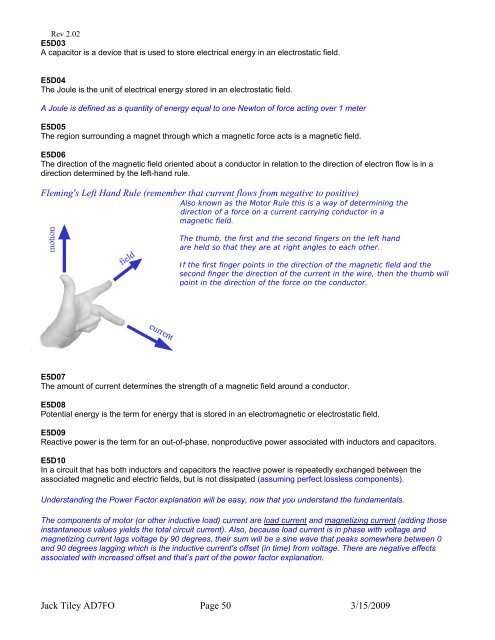Create successful ePaper yourself
Turn your PDF publications into a flip-book with our unique Google optimized e-Paper software.
Rev 2.02<br />
E5D03<br />
A capacitor is a device that is used to store electrical energy in an electrostatic field.<br />
E5D04<br />
The Joule is the unit of electrical energy stored in an electrostatic field.<br />
A Joule is defined as a quantity of energy equal to one Newton of force acting over 1 meter<br />
E5D05<br />
The region surrounding a magnet through which a magnetic force acts is a magnetic field.<br />
E5D06<br />
The direction of the magnetic field oriented about a conductor in relation to the direction of electron flow is in a<br />
direction determined by the left-hand rule.<br />
Fleming′s Left Hand Rule (remember that current flows from negative to positive)<br />
Also known as the Motor Rule this is a way of determining the<br />
direction of a force on a current carrying conductor in a<br />
magnetic field.<br />
The thumb, the first and the second fingers on the left hand<br />
are held so that they are at right angles to each other.<br />
If the first finger points in the direction of the magnetic field and the<br />
second finger the direction of the current in the wire, then the thumb will<br />
point in the direction of the force on the conductor.<br />
E5D07<br />
The amount of current determines the strength of a magnetic field around a conductor.<br />
E5D08<br />
Potential energy is the term for energy that is stored in an electromagnetic or electrostatic field.<br />
E5D09<br />
Reactive power is the term for an out-of-phase, nonproductive power associated with inductors and capacitors.<br />
E5D10<br />
In a circuit that has both inductors and capacitors the reactive power is repeatedly exchanged between the<br />
associated magnetic and electric fields, but is not dissipated (assuming perfect lossless components).<br />
Understanding the Power Factor explanation will be easy, now that you understand the fundamentals.<br />
The components of motor (or other inductive load) current are load current and magnetizing current (adding those<br />
instantaneous values yields the total circuit current). Also, because load current is in phase with voltage and<br />
magnetizing current lags voltage by 90 degrees, their sum will be a sine wave that peaks somewhere between 0<br />
and 90 degrees lagging which is the inductive current's offset (in time) from voltage. There are negative effects<br />
associated with increased offset and that’s part of the power factor explanation.<br />
Jack Tiley <strong>AD7FO</strong> Page 50 3/15/2009


